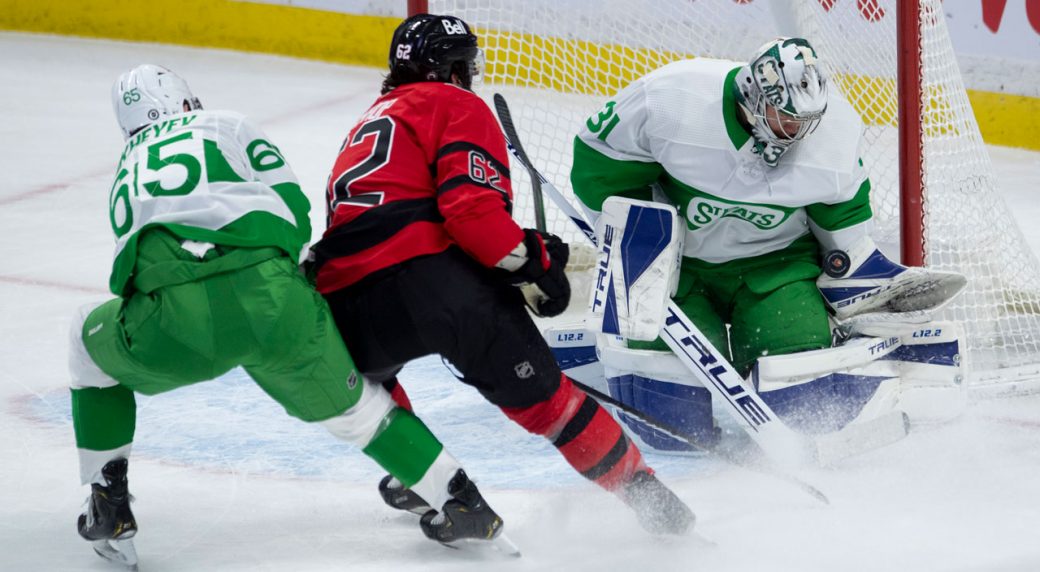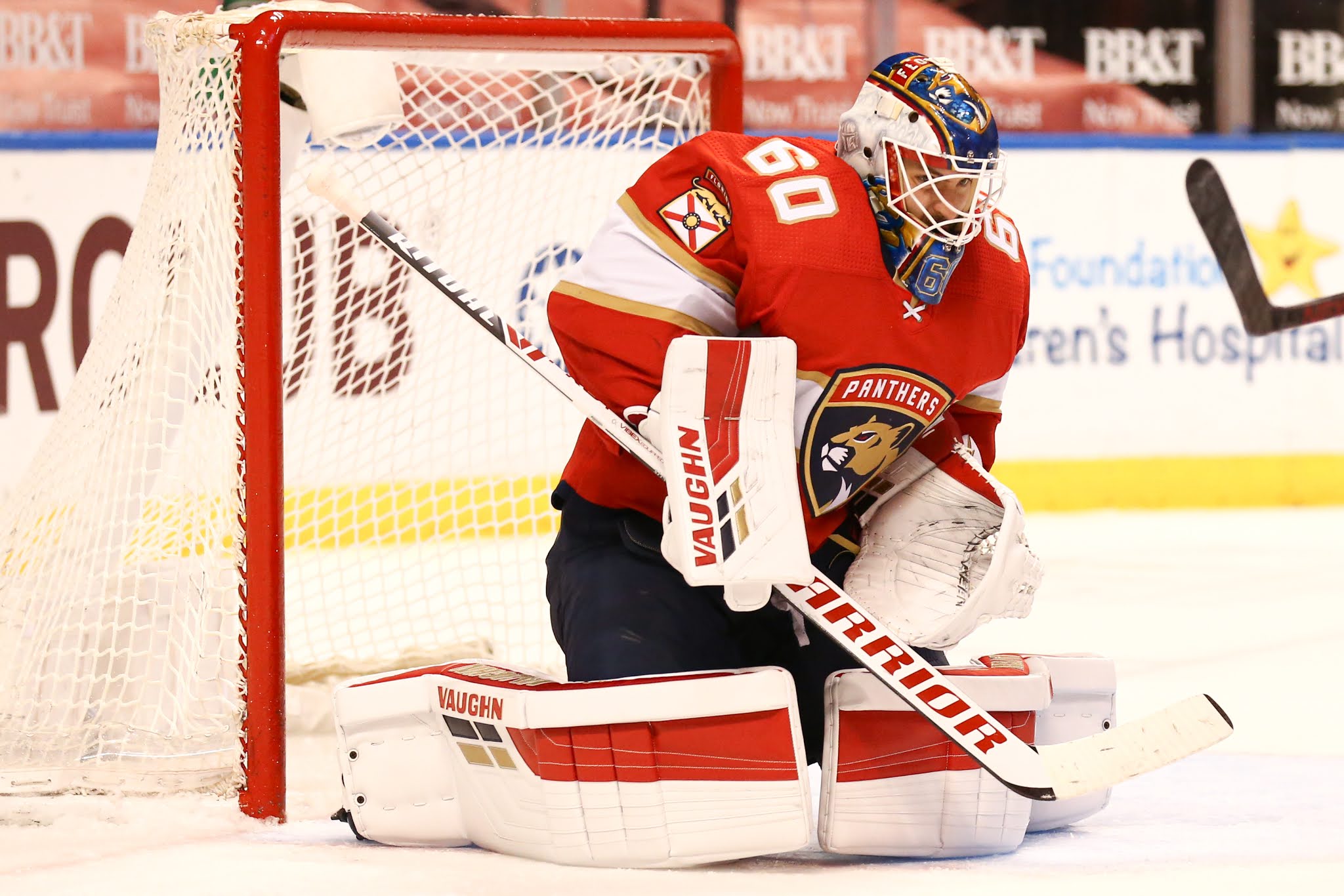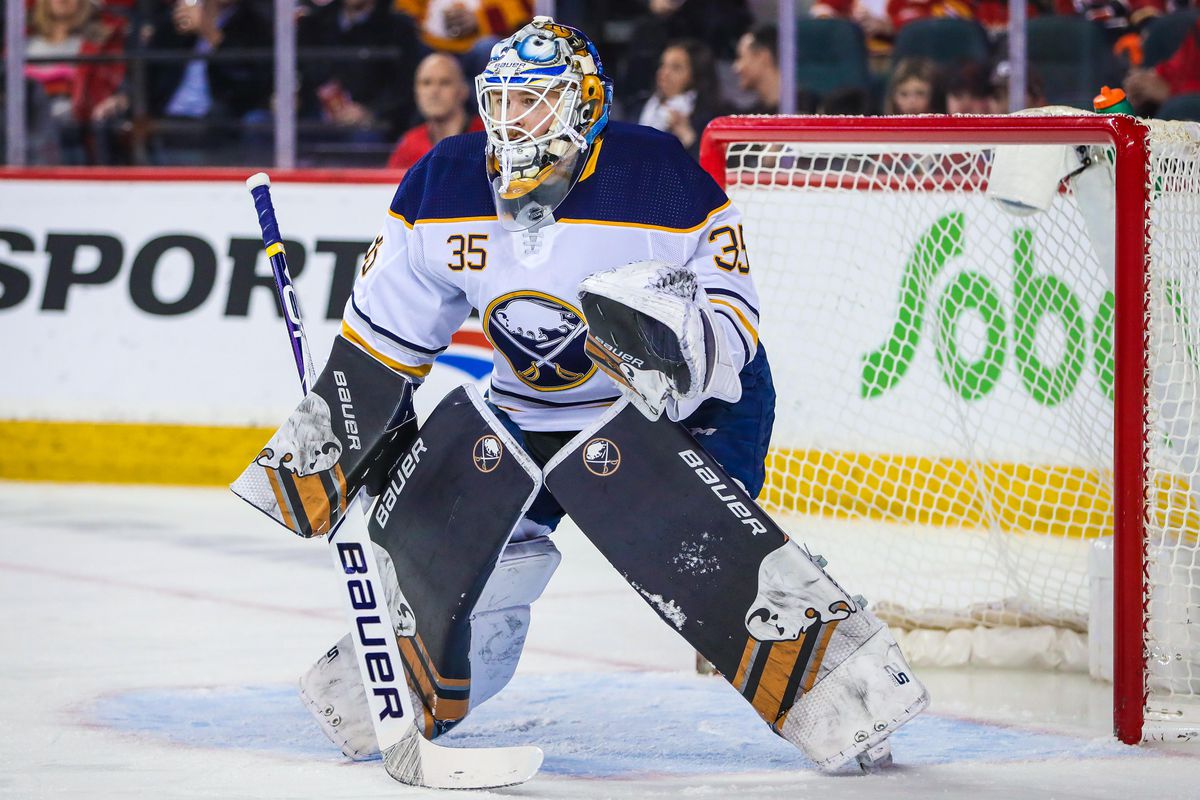The Maple Leafs are bound to add a goalie this offseason, whether through free agency or trade.
Both Frederik Andersen and David Rittich are set to hit free agency, and there isn’t an NHL-ready goalie prospect on the Marlies. Jack Campbell is the clear starter heading into next season, but he’s yet to play 40 games in an NHL season. The Leafs will certainly need a strong backup option.
Toronto’s front office will need to determine how much they are willing to spend on the goaltending position. The team has other needs to fill — particularly up front — and every extra dollar they spend on goaltending is a dollar less to spend elsewhere. Adding to the complexity, Campbell — entering the final year of his current deal — will surely command a healthy raise on his $1.65 million cap hit a year from now.
The Leafs could look to mimic the Vegas Golden Knights, a team that boasts two legitimate NHL starting goaltenders. Everyone knows that goaltending is the most important position in hockey, and if one of Vegas’ goalies struggles or gets injured, the team barely misses a beat. The Leafs could also look to mimic the Tampa Bay Lightning, a team that puts all their eggs into their starting goalie’s basket and spends close to nothing on their backup goalie. The saved cap space goes towards making the forward and defense groups as strong as possible.
The answer for the Leafs is probably somewhere in the middle between Vegas and Tampa. Campbell is coming off a strong season, but he simply doesn’t have the same track record as Andrei Vasilevskiy. There’s obviously too much risk involved if someone like Michael Hutchinson is the backup.
On the other hand, while adding a goalie like Philipp Grubauer would sure be nice, the Leafs aren’t exactly swimming in cap space right now, and they have forward needs to address. Adding a goalie in the $2 million to $4 million range seems likely, but as always, I expect the team to be open-minded in its contemplation of all available options.
The Incumbent

I’m not expecting Frederik Andersen to return next season, but we can’t rule it out completely. He posted a .895 save percentage in 24 games last season after a rather pedestrian .909 save percentage in 52 games in the 2019-20 season. It’s now been two seasons since we’ve seen the old version of Andersen — not to mention his fair share of struggles come playoff time.
There are also some valid questions in terms of durability now, as both Andersen and Campbell missed time due to injuries this season. Given Campbell’s history, it’s important for his backup to be durable.
The case for Andersen is his upside. He was one of the most consistent goaltenders in the NHL across his first three seasons in Toronto, and if he can get back to his former self, he’ll be a free agent steal. He’s only 31 — a bounce-back season isn’t out of the realm of possibility. It’s not like they’re asking a 40-year old Craig Anderson to bounce back to Vezina form.
The Leafs also know more about Andersen than any other team. They should be in the best position to determine how much injuries affected his performance and whether or not these injuries are expected to linger in the future. While he’s struggled at times in the playoffs, if the Leafs were worried that he couldn’t handle the pressure, they wouldn’t have brought him back last season.
After two rough seasons, Andersen may welcome a change of scenery. He wouldn’t be a traditional backup in Toronto — Campbell likely won’t play as much as someone like Vasilevskiy — but Andersen certainly wouldn’t be the 1A option to start the season. Even if he bounces back and plays well, he might end up on the bench come playoff time.
I expect Andersen to take a short-term deal and try to re-establish his value. Taking a slight discount, or signing with a rebuilding team, could help him to find an opportunity where he’s the clear #1 option to start the season. Even if he plays well in Toronto, the Leafs could simply stick with Campbell beyond next season, leaving him with no guarantee that the Leafs would give him a big payday next offseason.
If the Leafs are confident that Andersen can bounce back, it makes sense to make an overture about keeping him. The team can promise him a fair amount of playing time, although he can probably find a better opportunity elsewhere.
If Andersen does stay in Toronto, he’ll likely have to take a discount, as they don’t exactly have a ton of cap space to allocate to a goalie who has struggled in back-to-back seasons. Despite dealing with an injury, he was still slightly above average by Evolving Hockey’s goals saved above expected at 5-on-5 last season. As I’ve written previously, he was incredibly unlucky while the Leafs were shorthanded this season. It’s easy to see a healthy Andersen bouncing back. Among the names on this list, he’s one of the options with the most upside.
Ultimately, either side could say “we think we have better options,” making a deal more unlikely than not. The Leafs could look to add someone with better numbers over the last two years, or they could look to target a cheaper option that would allow them to spend more elsewhere.
On the other side, Andersen could simply sign with the team that offers him the most money, or he could look for an opportunity to be a true #1 starter somewhere. It’s more likely that he signs elsewhere.
Free Agency

Chris Driedger
Driedger is 6’4″, 27, and boasts a .926 save percentage in 41 career NHL games. Given that the Panthers already have Spencer Knight and Sergei Bobrovsky in net, it’s tough to see Driedger re-signing in Florida. While he could likely find a starter’s job somewhere, signing with the Leafs would give him a chance to contend. The team could easily promise him 30-35 starts.
The case for signing Driedger is simple: You just need him to keep doing what he’s doing. After posting a .927 save percentage in 23 games last season, you still have a very good goalie on your hands even if he takes a small step backward. Unlike Andersen, you don’t have to hope for a bounce-back season, nor do you have to pay a premium based on what he was two years ago.
The case against Driedger: He’s still a bit of a mystery box. His numbers are terrific through 41 career games, but so were Andrew Hammond’s. With just 15 starts at the highest level prior to this season, this was the first year that he started more NHL games than AHL games. It’s certainly possible that he’s an average backup goalie who just got hot. We’ve seen a great 41-game stretch from Curtis McElhinney, for example.
Just like almost any free agent, this will come down to cost. If a team views him as a good long-term starter, he could be out of Toronto’s price range. Given his age, a long-term deal is definitely possible. There are a few teams like Tampa Bay that almost definitely won’t be in on him, but he could make sense for both contenders and rebuilding teams.
As we saw with Matt Murray last offseason, it only takes one team to put a big offer on the table. The Leafs can offer a reasonable amount of playing time, but another team could certainly offer more in terms of both dollars and opportunity. This all comes down to one question: How much do you believe in his 41-game sample? I’m not ready to call him the Leafs’ next saviour, but he should probably be on their shortlist.
Linus Ullmark
After he wasn’t traded at the deadline, it seems like there is a good chance that Ullmark will re-sign with the Sabres. However, he’s coming off back-to-back strong seasons, and there will definitely be plenty of interest if he hits the open market. Like Driedger, he’s also both 6’4″ and 27, so a longer-term deal is likely.
If Ullmark wants to be his team’s undisputed #1 starter heading into next season, he’ll likely stay in Buffalo. If he’s willing to sacrifice a little bit of playing time in order to play for a playoff team, the Leafs could definitely be an option. However, it’s worth noting that this could be the biggest payday of his career. It would be quite surprising if he took a discount to sign with one particular team rather than jumping at the best offer available.
Ullmark has nearly three times more NHL games under his belt than Driedger, yet he’s still rather unproven. He’s never played in a playoff game, and he’s also just two seasons removed from posting a .905 save percentage in 37 games. Like Driedger, the question becomes: Can he be the same goalie he was over the last two years? If so, he’s certainly a solid 1B option.
I expect him to sign with the Sabres, and the Leafs may not even get a chance to speak to him. Even if he does hit the open market, given their lack of cap space, I don’t see the Leafs getting in a major bidding war for him. He’s a pretty good goalie who would be a strong 1B option behind Campbell, but I think Ullmark to Toronto is a bit of a long shot.
Petr Mrazek
Mrazek is a tough goalie to get a read on given his ups and downs over the years. While he managed to post a .923 save percentage this season, he missed time due to multiple injuries and only ended up playing in 12 games. Given that he’s just one season removed from a .905 save percentage in 40 games, it’s tough to see him landing a big long-term deal this offseason.
After signing a two-year deal with a $3.125 million AAV in the 2019 offseason, I expect Mrazek to end up in that same ballpark. He could end up staying in Carolina to be the 1B option to Alex Nedeljkovic, who is coming off a strong rookie reason. However, it’s easy to see the Hurricanes allowing him to hit the open market while looking for a better option to help replicate Vegas’ 1-2 punch of Fleury and Lehner. Even if the Hurricanes want to bring him back, they may not end up making the best offer.
If the price is right, it’s easy to envision Mrazek as a 1B option to Jack Campbell. He’s been more of a 1B option than a true #1 starter for the majority of his career. He’s also no stranger to the NHL playoffs. I don’t see him getting an opportunity to be a true #1 elsewhere, and the Leafs should have plenty of playing time to offer.
Per Cap Friendly, Mrazek has made over $17 million during his NHL career. Unlike someone like Driedger, it’s easy to see him taking a little bit less in order to find the right fit. I can’t see him burying himself behind Vasilevskiy or Hellebuyck just for $200k more. While I’m not jumping in excitement over the possibility of signing Mrazek, he’s an available 1B goalie, which is exactly what the Leafs are in the market for.
Antti Raanta
Raanta boasts a career save percentage of .919 through 196 career games. That’s right in line with Andrei Vasilevskiy and Tuukka Rask, but he’s never played 50 games in a season. He’s had his fair share of injuries over the years, but it’s clear that he’s more than capable of a big year in the right circumstances.
Raanta posted a .905 save percentage in just 12 games this season — a nearly identical stat line as the 2018-19 season. In between those seasons, he posted a .921 save percentage in 33 games. His career high-water mark is the .930 he posted in 47 games back in 2017-18. To sum it up: great year, injured year, great year, injured year.
If you get one of his good years, there’s a chance that Raanta is the starter come playoff time, even if Campbell is playing fairly well. However, even if his injury history drives down his price, there’s still quite a bit of risk here. If he is hurt again, the Leafs could be left with a Michael Hutchinson figure playing more than they would like, necessitating a trade for help at the deadline. There is also a chance that the injuries catch up to Raanta and he ends up looking more like the .905 goalie that he was this season through 12 games.
The Coyotes have Darcy Kuemper and Adin Hill, so it won’t be a surprise if Raanta ends up looking for a 1B opportunity somewhere else. The Leafs could easily find enough playing time for both him and Campbell. Like Mrazek, he’s made about $17 million over his NHL career, so expect him to look for the best opportunity rather than burying himself in the depth chart for an extra $200k. Playing for a playoff team like the Leafs could certainly interest him.
Raanta seems like a legitimate option for the Leafs, but it’s clear that he’s a high-risk, high-reward option. If he is able to heat up and stay healthy at the right time, he could easily steal a playoff round or two.
However, pursuing a Mrazek or Ullmark is probably a safer option, especially when you consider that Campbell has never played 40 games in an NHL season. Adding Raanta for a one-year deal at a low AAV could make sense, but you better be comfortable with your third-string goalie.
Laurent Brossoit
Brossoit posted a .918 save percentage in 14 games this past season, including a .938 in his two starts against the Leafs. At 28 years of age, if he has any interest in an opportunity to make a name for himself, he needs to run far away from Connor Hellebuyck. A big offer could always change his mind, but I’ll be surprised if he stays in Winnipeg.
Like many of the goalies on this list, Brossoit has been inconsistent year to year. He’s played between 14 and 21 games in each of the past four seasons with save percentages of .883, .925, .895, and .918. Over his career, he has a .908 save percentage through 82 games, which is essentially league average.
Expect to see more of him once he leaves Winnipeg, especially if he continues to play like he did this season. He could end up being one of the bargains of the offseason as a hidden gem who was buried behind Hellebuyck for three seasons. However, it’s also not hard to picture him posting a save percentage under .900 as he did in 2019-20 and 2017-18 before ending up in the AHL by midseason.
Brossoit should be pretty cheap — he’ll probably end up being paid like a good backup rather than a true 1B option. If the Leafs like him, they could give him plenty of playing time in the first half and make a trade at the deadline if it’s not working out.
I like that he’s 6’3″ and comes without any major durability concerns. Signing him on the cheap could allow the Leafs to spend more elsewhere, but they may decide to go with someone who carries a track record as a starter.
Mike Smith
Smith will be 40 by the time next year’s playoffs roll around, but he posted a .923 save percentage in 32 games for the Oilers this season. It’s tough to see him getting a better opportunity than with the Oilers, who have already stated that they want to re-sign him. He’ll likely be the favourite to start game one of the playoffs if he signs with the Oilers — that won’t be the case if he signs in Toronto.
Smith was terrible in his two previous seasons, and like many of the goalies on this list, it’s tough to predict how he’ll fare next season. How much he’ll cost is also tough to predict — he made just $1.5 million this season, but he is almost surely going to get a raise. Apart from the fact that he’s coming off a strong season, Smith’s main selling point is his durability, which would complement Campbell nicely.
A Kingston native, Smith has made close to $47 million in his career. I’m a bit hesitant to sign a 39-year old goalie who has been bad in two of the past three seasons, but if he wants to take a big discount to play in Toronto, the Leafs could be interested.
I fully expect Smith to re-sign in Edmonton, but I suppose we can’t rule him out completely. I just don’t think he’s been good enough over a larger sample to warrant much consideration.
Jonathan Bernier
Leafs fans are already very familiar with Bernier, who missed the Matthews-Marner era by just one season. The soon-to-be 33-year-old owns a .913 save percentage through nearly 400 NHL games, including a .915 save percentage in his three seasons in Toronto. He posted a .914 in 24 games with Detroit this season, so it’s certainly possible that he’s the same goalie that he’s always been.
Like Mrazek, Bernier carries a long track record as a 1B option. Fairly durable over the years, he can be penciled in for 30+ games, which is a clear advantage over an option such as Raanta. After carrying a $3 million cap hit over the past three seasons, I expect him to end up in that range once again.
Like Ullmark, Bernier wasn’t traded at the deadline and it’s certainly possible that he ends up re-signing with his current team. If he does hit the open market, he could sign just about anywhere as a premium backup or 1B option.
Would he want to return to the hockey mecca that is Toronto? I think it’s a bit of a long shot, but never say never. If the Leafs decide to be patient and he’s one of the last goalies that’s available, I wouldn’t rule it out. However, if Toronto’s front office really liked him, I think they would have paid a little bit extra to get him at the deadline over Rittich.
James Reimer
Who doesn’t enjoy a good Bernier vs. Reimer debate?
Now 33, Reimer is coming off a rough season in Carolina with a .906 save percentage in 22 games. He also had a .900 save percentage back in 2018-19 in 36 games for the Florida Panthers, so he’s struggled in two of his past three seasons.
It’s easy to see Reimer signing elsewhere. Alex Nedeljkovic is now the starter in Carolina, who could either re-sign Mrazek or look to upgrade. However, the Leafs may want to opt for someone who is coming off of a better season.
The main selling point with Reimer is his price tag. Cheaper than most of the options on this list, the Manitoba native may even take a discount to return to where his career began. Per Cap Friendly, he’s already made $27 million in his career, and he’s likely looking at a one-year deal this summer. The Leafs could offer him more playing time than he’d get just about anywhere else. He would form the most amiable 1-2 goalie tandem in NHL history with Jack Campbell.
If he signs with the Leafs, expect him to take a slight discount and make close to the league minimum. He’s just one season removed from posting a .914 save percentage in 25 games — and a career save percentage of .913 is definitely respectable — but most teams will probably see him as more of a true backup at this point rather than a 1B type.
Given his recent struggles, I’m not sure how much faith I’d have in Reimer in a playoff series right now. The Leafs may end up spending a little bit more on their backup goalie, but if Reimer wants to sign for around the league minimum, Toronto’s front office might at least consider it. I just don’t think he’s been good enough to warrant much further consideration.
Jaroslav Halak
Now 36 years old, Halak posted a very similar stat line to Reimer last season, which leaves something to be desired. However, he was the perfect 1B goalie behind Rask over the previous two seasons in which he hovered around the .920 save percentage mark. If he bounces back, he’d be the perfect 1B starter for Campbell and could be the bargain of the offseason. However, given his age, banking on a bounce-back season is certainly a gamble.
A return to Boston is unlikely, as it sounds like Tuukka Rask would like to re-sign and 22-year old Jeremy Swayman made a strong first impression last season. Unless he retires, I expect Halak to try to sign with a contender. Money won’t likely be a major factor given that he’s made over $41 million in his career and definitely took less to sign with Boston last offseason.
I could see him signing with Tampa, but retirement could be a possibility as well. The Leafs could certainly ask him to take less, but if they do end up signing him, Toronto brass would be wise to make sure there’s a strong third-string option in place. If Campbell goes down, it’s tough to completely rely on a 36 year old who played 19 games last season.
My guess is that the Leafs go with a younger option, but like Reimer, if Halak is willing to take a discount, they’ll have to consider it. One of the more underrated players in the league over the past 15 years or so, Halak could have some gas left in the tank. Given that he was very good in the previous two seasons, he’s worth taking a chance on for someone. However, my guess is Tampa rather than Toronto.
In the second part of this article, we will outline trade and other long-shot options before wrapping up with final thoughts on the goaltending options.



![Sheldon Keefe on the Maple Leafs’ struggling power play: “[We’ve scored] one out of 11 high-danger chances in tight to the net… We have been in those spots and haven’t converted” Sheldon Keefe, playoff press conference](https://mapleleafshotstove.com/wp-content/uploads/2024/04/keefe-pc-game-3-218x150.jpg)

![Jim Montgomery Post Game, Bruins 4 vs. Leafs 2: “[Marchand] still manages to get under people’s skin, yet he doesn’t cross the line” Jim Montgomery, Boston Bruins post game](https://mapleleafshotstove.com/wp-content/uploads/2024/04/jim-monty-pg-to-218x150.jpg)
























![Sheldon Keefe on the Maple Leafs’ struggling power play: “[We’ve scored] one out of 11 high-danger chances in tight to the net… We have been in those spots and haven’t converted” Sheldon Keefe, playoff press conference](https://mapleleafshotstove.com/wp-content/uploads/2024/04/keefe-pc-game-3-100x70.jpg)



![Jim Montgomery Post Game, Bruins 4 vs. Leafs 2: “[Marchand] still manages to get under people’s skin, yet he doesn’t cross the line” Jim Montgomery, Boston Bruins post game](https://mapleleafshotstove.com/wp-content/uploads/2024/04/jim-monty-pg-to-100x70.jpg)
